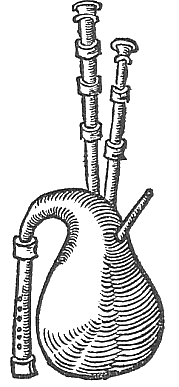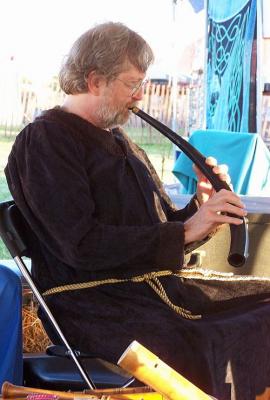Shawm
 (the renaissance shawm)
(the renaissance shawm)
"At great feasts they are to play upon shagbut, cornetts,
shawms and other instruments going with wind."
-Richard Brathwaite, 1621
click image for alto shawm sound (134kb wav)
or here for same in mp3
canario - dance tune by Fabritio Caroso
(second verse by alto shawm)
ein feste burg - three settings by Walther
(first setting includes tenor shawm, alto zink and crumhorn)
Unlike the medieval shawm, the late Middle Ages and Renaissance shawm uses a broad cane reed controlled by the player's lips. With the smaller size shawms, the reed could be placed inside a pirouette, a funnel shaped protector against which the player places his lips. This pirouette not only protects the reed, but also helps avoid lip fatigue.
 The shawm band enlivened the palace courtyard and market square of the sixteenth century and added to the general din and confusion associated with them.
The shawm band enlivened the palace courtyard and market square of the sixteenth century and added to the general din and confusion associated with them.
"Clown: Why, masters, have your instruments been at Naples, that they speak i' th' nose thus?
Musician: How, sir, how?
Clown: Are these, I pray, call'd wind instruments?
Musician: Ay, marry, are they, sir.
Clown: O. therey hangs a tail.
Musician: Whereby hangs a tale, sir?
Clown: Marry, sir, by many a wind instrument that i know. But, masters, here's money for you; and the General so likes your music, that he desires you, of all loves, to make no more noise with it."
-Shakespeare, Othello
 All shawms have several vent holes between the hole for the lowest note and the end of the bell. This section of the instrument is very long and contributes to the tone and carrying power of the instrument. A large fontanelle protects the key mechanism of the lowest note(s), and the crenellated metal band often found wrapped around the bell not only helps protect the instrument but also helps make the shawm a sturdy weapon for settling disputes among town musicians.
All shawms have several vent holes between the hole for the lowest note and the end of the bell. This section of the instrument is very long and contributes to the tone and carrying power of the instrument. A large fontanelle protects the key mechanism of the lowest note(s), and the crenellated metal band often found wrapped around the bell not only helps protect the instrument but also helps make the shawm a sturdy weapon for settling disputes among town musicians.
Musica Antiqua's shawms include a soprano in c1 by Hermann Moeck, two altos in f by Moeck, a tenor in c by Moeck, a soprano in c1 by John Hanchet, and an alto in f by Collier.
Additional Resources:
- S. Virdung: Musica getutscht (Basle, 1511/r1970)
- M. Agricola: Musica instrumentalis deudsch (Wittenberg, 1529/r1969)
- O. de La Marche: Memoires (Lyons, 1562)
- T. Arbeau: Orchesographie (Langres, 1588)
- C. de la Ruelle: Decem insignes tabulae, complexae icones justorum ac honorum supremorum, corpori serenissimi principis(Nancy, 1611)
- M. Praetorius: Syntagma musicum ii, iii (Wolfenbuttel, 1618/r1958)
- M. Mersenne: Harmonie universelle (Paris, 1636/r1963)
- J. Talbot: Musica (MS, GB-Och Mus.1187, c1697)
- E. vander Straeten: La musique aux Pays-Bas avant le XIX siecle, iv (Brussels, 1878/r1969)
- A. Sandberger: Introduction to H. L. Hassler: Werke II, DTB, viii, v/1 (1904)
- H. C. de Lafontaine: The King's Musick (London, 1909/r1973)
- F. W. Galpin: Old English Instruments of Music (London, 1910)
- K. Weinmann: Johannes Tinctoris, 1445-1511, und sein unbekannier Traktat 'De inventione et usu musicae' historische-kritische Untersuchung (Regensburg, 1917)
- C. Sachs: Sammlung alter Musikinstrumente bei der Staatlichen Hochschule fur Musik zu Berlin (Berlin, 1922)
- G. Kinsky: 'Doppelrohrblatt-Instrumente mit Windkapsel', AMw, vii (1925), 253-96
- A. Schering: Musikgeschichte Leipzigs, ii (Leipzig, 1926)
- P. Bromse: Floten, Schalmein und Sackpfeifen der Sudslawen (Brno, 1937)
- A. Baines: 'James Talbot's Manuscript: I: Wind Instruments', GSJ, i (1948), 9
- W. L. Woodfill: Musicians in English Society from Elizabeth to Charles I (Princeton, 1953/r1969)
- P. Bate: 'Shawm and Oboe Embouchure', GSJ, viii (1955), 60
- A. Baines: Woodwind Instruments and their History (London, 1957)



 Musica Antiqua's shawms include a maple sopranino in f1 and a soprano in c1 by Gunther Koerber.
Musica Antiqua's shawms include a maple sopranino in f1 and a soprano in c1 by Gunther Koerber.
 During the Renaissance, the bagpipe gradually moved from country to court. Both Edward II and Edward III had pipers at court. King Henry VIII, composer and music patron, also had an extensive collection of instruments which, according to a contemporary account, included wone with pipes of ivorie and a bagge covered with purple vellat. As a rustic instrument it has been immortalized in the paintings of Pieter Breughel and his contemporaries.
During the Renaissance, the bagpipe gradually moved from country to court. Both Edward II and Edward III had pipers at court. King Henry VIII, composer and music patron, also had an extensive collection of instruments which, according to a contemporary account, included wone with pipes of ivorie and a bagge covered with purple vellat. As a rustic instrument it has been immortalized in the paintings of Pieter Breughel and his contemporaries. Musica Antiqua's collection includes a replica with two drones patterned after Brueghel's Peasant Wedding, and a Hummelchen (little bumblebee) bagpipe which is modelled after the smallest of the four included in Praetorius' Syntagma Musicum of 1619. The Brueghel model is smaller than a highland pipe and loud, but not as piercing as a today's highland pipes. The Praetorius model is tiny and has sweet and delicate tone, making it useful both as a solo instrument and in ensemble with other Renaissance instruments. The chanter has a range from c1 to d2 and two drones tuneable to f and c or g and d. This boxwood replica was made by Wolfgang Lentelme of Germany.
Musica Antiqua's collection includes a replica with two drones patterned after Brueghel's Peasant Wedding, and a Hummelchen (little bumblebee) bagpipe which is modelled after the smallest of the four included in Praetorius' Syntagma Musicum of 1619. The Brueghel model is smaller than a highland pipe and loud, but not as piercing as a today's highland pipes. The Praetorius model is tiny and has sweet and delicate tone, making it useful both as a solo instrument and in ensemble with other Renaissance instruments. The chanter has a range from c1 to d2 and two drones tuneable to f and c or g and d. This boxwood replica was made by Wolfgang Lentelme of Germany. 

 Very little breath is used in playing the zink. Mersenne mentions a French court musician, M. Sourin of Avignon, who could play one hundred measures in one breath!!
Very little breath is used in playing the zink. Mersenne mentions a French court musician, M. Sourin of Avignon, who could play one hundred measures in one breath!! Musica Antiqua's collection of small size zinks includes a soprano zink in c1 by Monk, a soprano in c1 and an alto in a by Moeck, and a nicolo in c by Monk. See the
Musica Antiqua's collection of small size zinks includes a soprano zink in c1 by Monk, a soprano in c1 and an alto in a by Moeck, and a nicolo in c by Monk. See the 
 click on image for psaltery sound (140kb wav)
click on image for psaltery sound (140kb wav)  The name of psaltery entered Christian literature in the 3rd century B.C. translation of the Old Testament called the Septuagint where, in the Psalms, nebel was translated psalterion. Thus, Nebuchadnezzar's idolatrous ensemble included the Aramic psantria. Notice, also, that the book of Psalms has also become known as the Psalter (or psalterium), from the hymns sung with this harp.
The name of psaltery entered Christian literature in the 3rd century B.C. translation of the Old Testament called the Septuagint where, in the Psalms, nebel was translated psalterion. Thus, Nebuchadnezzar's idolatrous ensemble included the Aramic psantria. Notice, also, that the book of Psalms has also become known as the Psalter (or psalterium), from the hymns sung with this harp. 
 He kiste hire sweete and taketh his sawtrie,
He kiste hire sweete and taketh his sawtrie,

 Renaissance recorders differ from Baroque recorders in that they have a larger bore which gives a stronger low register, making them better suited for blend and ensemble playing. Recorders from this period generally have smaller range than the Baroque recorders.
Renaissance recorders differ from Baroque recorders in that they have a larger bore which gives a stronger low register, making them better suited for blend and ensemble playing. Recorders from this period generally have smaller range than the Baroque recorders.


